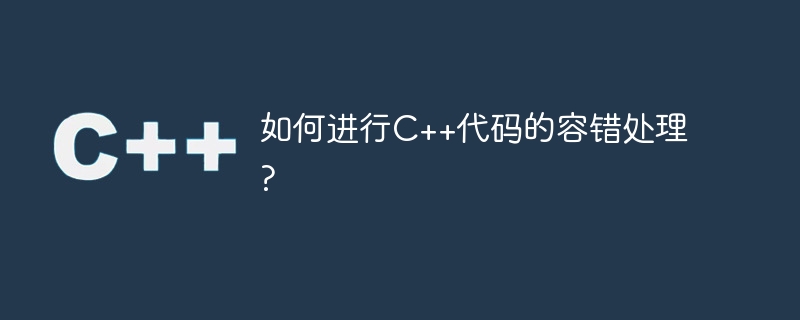Home >Backend Development >C++ >How to perform fault tolerance in C++ code?
How to perform fault tolerance in C++ code?
- WBOYWBOYWBOYWBOYWBOYWBOYWBOYWBOYWBOYWBOYWBOYWBOYWBOriginal
- 2023-11-02 13:48:221571browse

How to perform fault-tolerant processing of C code?
Abstract: Fault-tolerant processing is a very important part of programming, especially in C code. This article will introduce some common methods of fault-tolerant handling of C code, and provide some sample code to illustrate how to avoid common errors and exceptions.
Introduction: C is a powerful programming language, but it also has some confusing features, such as pointers and memory management. These features make fault tolerance a critical part of writing high-quality C code.
1. Code static inspection
Static inspection is to check the code during compilation to find potential errors. C provides tools and techniques for static checking, such as compiler warnings. Developers should follow good programming practices and set compiler warnings to errors to ensure the quality of their code.
The following are some common static checking techniques:
1. Enable compiler warnings: C compilers usually provide some warning options, and the compiler warning level can be set through the command line or IDE. Developers should enable as many warnings as possible and treat warnings as errors.
2. Use static analysis tools: Static analysis tools can help developers find potential problems and errors. For example, Cppcheck is a popular open source static analysis tool that can help developers find common errors in their code.
2. Exception handling
Exception handling is a mechanism to perform different operations or take different measures when encountering errors or abnormal situations. In C, you can use try-catch blocks to catch exceptions and execute corresponding processing logic.
The following are some common exception handling techniques:
1. Exception catching and processing: Use try-catch blocks to catch exceptions and execute corresponding processing logic. You can perform different operations based on different exception types, or expand exceptions for processing by upper-layer functions.
try {
// 可能抛出异常的代码块
} catch (ExceptionType1 e) {
// 处理 ExceptionType1 异常
} catch (ExceptionType2 e) {
// 处理 ExceptionType2 异常
} catch (...) {
// 处理其他所有类型的异常
}2. Exception safety: When writing code, exception safety should be considered. Even if an exception is thrown, ensure that resources are released correctly. RAII (Resource Acquisition Is Initialization) technology can be used to manage resources. RAII uses the object's constructor to perform initialization when a resource is obtained, and to perform release in the object's destructor.
3. Input validation and boundary checking
Input validation and boundary checking are important methods to ensure the correctness and security of the code. In C, user input should be validated to ensure that the input meets expected formats and constraints.
The following are some common input validation and bounds checking techniques:
1. Input validity check: Before reading user input, the validity of the input value should be checked. You can use regular expressions or other validation methods to verify that the input format is legal.
2. Boundary check: When processing data structures such as arrays and strings, the legality of the index should be checked. Ensures that no out-of-bounds memory is accessed, thus avoiding security issues such as buffer overflows.
4. Error handling and logging
Error handling and logging are very important for debugging and tracking problems in the code. Some error handling and logging techniques can be used to help developers provide better debugging information.
The following are some common error handling and logging techniques:
1. Error code: When a function returns, an error code can be used to indicate the status of function execution. The code calling this function can decide the next step based on the error code returned.
2. Exceptions and logging: In case an error or exception is encountered, an appropriate exception or logging should be generated to provide the details of the error. This information can be used for subsequent debugging and analysis.
try {
// 可能抛出异常的代码块
} catch (ExceptionType1 e) {
// 记录异常信息到日志文件
Log("ExceptionType1 caught: " + e.GetMessage());
} catch (ExceptionType2 e) {
// 记录异常信息到日志文件
Log("ExceptionType2 caught: " + e.GetMessage());
} catch (...) {
// 记录异常信息到日志文件
Log("Unknown exception caught");
}Conclusion: Fault tolerance is a crucial link in programming. This article introduces some common C code fault-tolerant processing methods, such as static checking, exception handling, input validation and boundary checking, error handling and logging, etc. By rationally applying these technologies and methods, the robustness and reliability of the code can be improved and the occurrence of errors and exceptions can be reduced.
The above is the detailed content of How to perform fault tolerance in C++ code?. For more information, please follow other related articles on the PHP Chinese website!
Related articles
See more- C++ compilation error: A header file is referenced multiple times, how to solve it?
- C++ compilation error: wrong function parameters, how to fix it?
- C++ error: The constructor must be declared in the public area, how to deal with it?
- Process management and thread synchronization in C++
- How to deal with data splitting problems in C++ development

